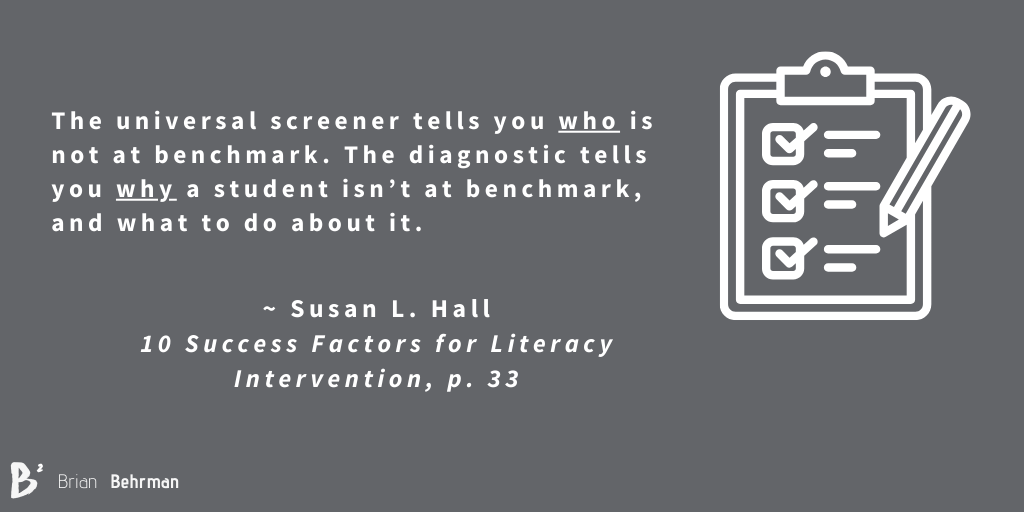I know that many of us have opinions about what it is that students need to know by the time they reach the end of any specific grade level. Those opinions are formed in several ways. One way is using grade-level standards, or another might be through our experience working with students at a particular grade. But how do we know if a student is struggling earlier than that? What should raise a red flag for us when a student isn’t progressing as fast as we think they should?
What research shows us, through a longitudinal study of approximately 400 randomly selected kindergarten students from a broad sample of communities across the state of Connecticut (you can see a bit more about this study here) is that early interventions are key. This study followed students until the end of high school. One of the interesting findings of the study is that between grades 1-9, students who started in the bottom 25 percent (the lowest one-quarter) of reading achievement remained there for the duration of the study. Students who were struggling in kindergarten were more likely to struggle throughout their educational career.
This is why early intervention is key to reading support. “Once children are behind – which happens very early – they do not catch up unless intervention is intensive, timely, and well informed” (Moats & Tolman, LETRS Volume 1, p. 63). Recent trainings on foundational skills continue to remind me of the importance of taking the right steps, at the right time.
Sometimes though, I feel like we get a little too caught up in the formality of interventions. If we see a student who is struggling, we shouldn’t feel like we need to wait for the next official MTSS meeting to add in some interventions. We also sometimes get too caught up in how long we need to spend on these skills. When the group is small, and a gap is identified early enough, just 5-10 minutes a day can make a world of difference. And those interventions don’t always have to happen while gathered around a table. If you have 3 kids that you’re concerned about their letter ID or naming of sounds, have them walk near you in line, and do the intervention while you walk them to a restroom break, to their related arts class, or lunch. When we use the small moments, and chunk them together, we can make BIG differences!
The first step in supporting students is knowing who to support – who falls into that bottom quarter of students. This is where a universal screener is so important. This is an assessment you might use for all students to see who is flagged as struggling with foundational reading skills. In my district, we use NWEA MAP Reading Fluency, however, other districts might use other screeners like Acadience Reading K-6, easyCBM, and others. This helps us locate the students who are at risk for reading difficulties.
Once we identify those students who are at risk, we may not know how we need to support that student That’s where diagnostic screeners are so important. There are lots of resources that you could use to help with screening students. Assessments such as The PAST Test (accessible for free here), or a Phonics and Word Reading Survey can help you see where your students are and identify where you might want to start an intervention. I would suggest using an assessment like this to screen your students of concern, then bring the data to a PLC meeting to see how you might be able to work as a team to support your learners in their continued growth.

The key to identifying the risks of reading struggles is to figure out where your students are as quickly as possible. Quality screeners are a huge part of that. Research suggests that screening should take place at least 3 times per year so that we can identify students who begin struggling later in the school year. Once students of concern are identified, we must get a quality intervention in place to support that student. The science tells us that most of our students can develop strong foundational reading skills – 95% or better – by the end of third grade. But the longer we wait to support students who are at risk, the harder that task becomes. Through appropriate intervention, we can make sure that many of our at-risk students are helped before chronic, serious reading and writing delays develop. This work must start on day 1 of kindergarten. We can’t afford to wait. Our student’s reading skills are too valuable!
Share with us in the comments. What are some of the things that you look for in your grade level to identify students who struggle? How might you intervene? We’d love to learn from one another!
Great post! I love using the transitional times to reinforce concepts and not limit it to small group work and other MTSS interventions.
One other idea I’m very fond of is letting parents know how they can help their child at home and give them the tools and resources to do so. All parents want their children to succeed and since they can more easily give individual attention, I believe it’s important to form an alliance with consistent communication to boost their child’s achievement.
LikeLike